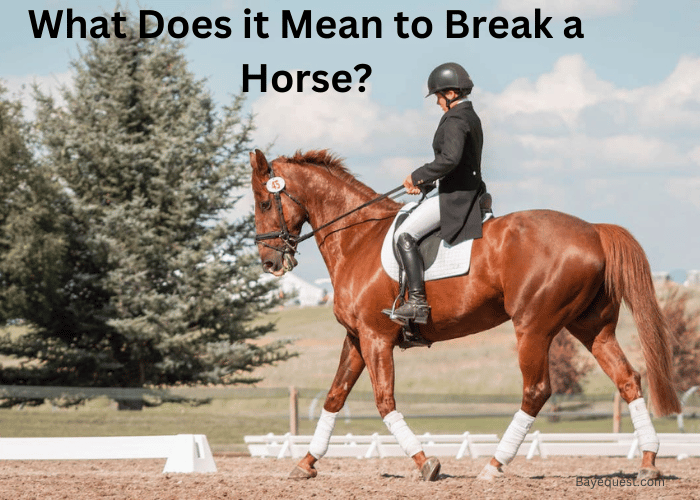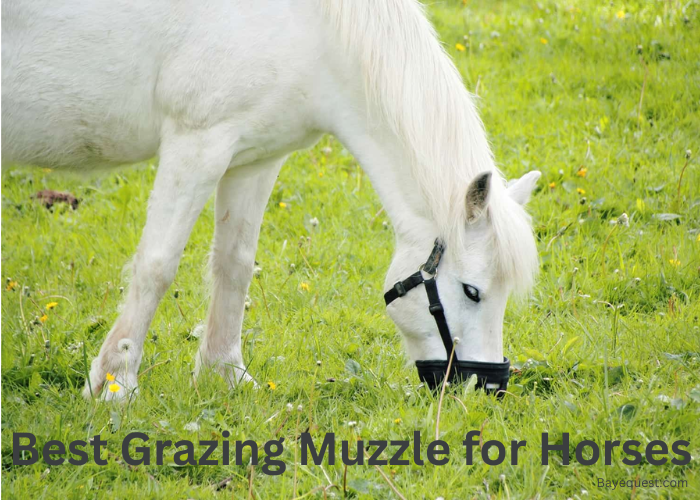Breaking is a vital stage in every horse’s life. It teaches the horse to obey human commands, making them safer to ride.
But it hasn’t always been pleasant. For example, many years ago, trainers used every crude tactic (and weapon) to “beat” the horse into shape.
It worked. But at what cost? Most of the horses sustained injuries and broken bones. Others also lost weight and became sick. And, yes, a few died.
This guide explains how horse breaking has changed and discusses the modern way to start your horse.
What Does it Mean to Break a Horse? Key Takeaway
To ‘break a horse’ means to train a horse to accept a rider and follow commands. This involves accustoming the horse to wearing a saddle and bridle and responding to cues. The aim is to build trust and communication between the horse and rider, ensuring the horse can be safely ridden.
What is Horse Breaking?
Horse breaking, also known as saddle breaking or, more recently, horse starting, is the process humans use to make horses rideable.
It is necessary because horses aren’t naturally rideable. They are wild animals that kick and bolt if you attempt to saddle them up and may bite when you attempt to climb their backs.
Breaking teaches them to accept riding and other human uses.
The process aims to produce a safe-to-ride horse that understands and responds positively to riding instructions, particularly steering and stopping commands. It also produces calm horses that are comfortable with riders on their backs.
Read also: Why Would a Horse Bite You?
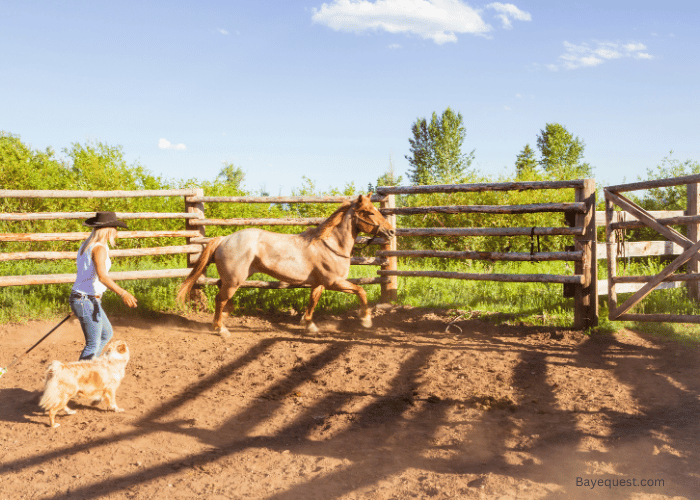
Stages of Breaking a Horse
The breaking process has four main stages: unbroken, saddle broken, dumb broken, and well broken.
Unbroken horses: A horse is unbroken if it has received no training concerning carrying a rider or load on their back or pulling a weight behind it. Unbroken horses don’t understand any riding or driving commands.
Saddle broke: Horses are saddle/halter/harness broken if they’ve received basic handling and riding training. Specifically, saddle broke horses are familiar with having riding equipment and even a rider on their backs. However, they don’t fully understand riding commands.
Dumb broke: If a horse is dumb/green broke, they’re past the saddle breaking stage. So they can have a rider on their back. However, they’re only beginning to learn critical riding commands, including acceleration, changing direction, and slowing down.
Well-broke: This is the final breaking stage. It means the horse has mastered being handled or ridden. The horse is familiar with the rider’s aids and understands all the important riding commands. Well-broken horses are also called “broken to death.”
4 Ways to Break a Horse
Horse breaking means the same thing, whichever approach you use. Nevertheless, different people apply strategies at various breaking stages for specific outcomes. The four main variations of the breaking process are;
1. Natural horsemanship
Natural horsemanship is a breaking philosophy that advocates aligning with the horse’s instincts and communication. The idea is to help the horse learn through pressure application and release rather than pain and suffering.
Therefore, this method involves applying pressure to the selected body parts as a cue for action. Then, you release the pressure as soon as the horse responds appropriately.
Notably, natural horsemanship doesn’t immediately seek perfection. Rather, you must release the pressure whenever the horse makes an effort in the desired direction. Moreover, the release of pressure is more important than pressure application. Therefore, you must release pressure immediately to reward the horse’s effort promptly.
2. Classical dressage
Classical dressage is a strategy that advocates for riding in harmony with the horse. The rider moves with the horse’s motion rather than against it, timing and applying the aids perfectly.
Think of it as cultivating and improving the natural gaits observed when the horse is at liberty, specifically the walking, trotting, and canter gaits.
Classical dressage emphasizes and encourages these gaits, producing keen and flexible horses with enhanced natural abilities.
The approach contrasts with competitive dressage, a cruel strategy that forces the horse to learn and perform difficult, unnatural gaits against their will.
Competitive dressage is most common in high-level horseback riding sports and competitions.
3. Old (cowboy) breaking
Cowboy breaking is one of the oldest ways to start a horse. It is also among the most cruel methods and almost forgotten in many societies.
The approaches varied. But generally, it involves tying the horse and throwing a saddle on their back. Then, the trainer jumps on the saddle, spurring the horse until the animal loses their spirit and energy and quits jumping.
You can already sense trouble with this approach. Though it may work, it’s risky. Often, someone gets hurt – either you or the horse. Worse still, horses never forget trauma. You may succeed today but will likely never have a cordial relationship.
4. Positive reinforcement
Finally, some professionals believe positive reinforcement produces the best result when breaking a horse. They aren’t far from the truth.
It’s a positive reward strategy that provides a positive stimulus when the horse obeys a command or makes a genuine attempt. Trainers issue a command and provide a reward for a positive response. However, a “bridge” signal can indicate success as the horse awaits the reward.
Bridge signals bridge the gap between the behavior’s moment and the reward provision. Common signals include whistling, clinkers, tongue pops, and special words or sounds.
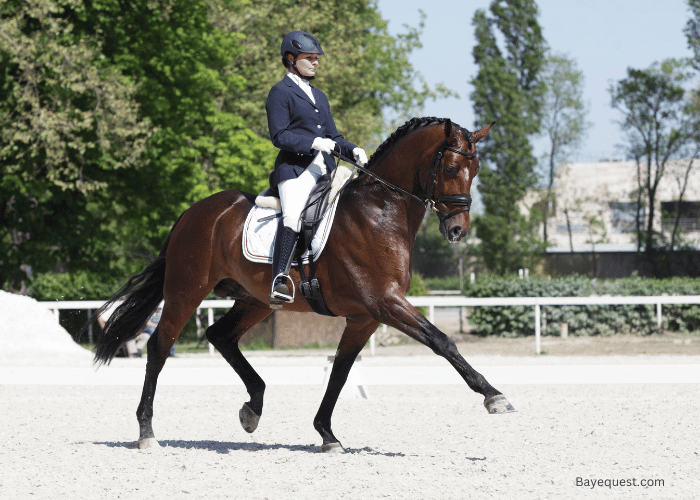
How to Break a Horse in 5 Steps
Thankfully, you don’t need to master every breaking method to prepare your horse for saddle riding. You can apply a few at different stages when needed.
But it’s not mandatory. Here’s an easy step-by-step guide to break your horse like a pro;
Step 1: Safety first
Though friendly, horses are fight-and-flight animals. They react unpredictably when threatened. So, learn how to stay safe around your horse before you begin training.
Specifically, learn about the horse’s field of view. Horses have monocular vision. Each eye focuses on half of the field of view and cannot see items on the other side of the head.
Moreover, horses cannot accurately discern objects in front of them. So, never stand directly in front of them or directly behind them.
The best position is on the horse’s side, angled towards the eye. This allows the horse to see you clearly without raising their head.
If you must go around, keep your hand on the animal’s body so they can track your movement. Additionally, talk to the horse when you’re out of sight so they know where you are.
They have good sense of hearing. Never kneel or squat next to the horse until they’ve mastered your movements.
Step 2: Earning Trust
After mastering the safety manoeuvres around the horse, it’s time to gain your horse’s trust. It makes breaking easier and less risky.
This should start at least two weeks before you begin the breaking process. Spending quality time with your horse is a great place to start.
It allows you to familiarize yourselves and learn more about each other. Grooming each other, as does talking and general communication, also creates deep, long-lasting bonds.
Finally, learn the horse’s cues and body language. This way, you can “hear” them quickly and respond promptly to their needs.
Step 3: Saddle-Breaking
Saddle or halter-breaking is easy once you strongly connect with the horse. The following is a step-by-step guide;
Start with a gentle touch: You want to get the horse used to your hands and touch. So, stand where the horse can see you and gently extend your hand to touch their body. Then run your hands over the head, ears, and neck. Repeat this a few times until the horse is comfortable with your touch.
Introduce the halter and bridle: Allow the horse to see and smell the halter and bridle for a few hours or days. Then, gently place the two onto the head, starting with the halter. Alternatively, introduce each on a different day.
Introduce the bit: You need to get the horse to open its mouth for this step. Be gentle and build up the process a little longer if needed. If that doesn’t work, add a layer of molasses to the bit. This may encourage the horse to open its mouth. Put the bit in the open mouth.
Next up, the ear pieces: Gently place the ear pieces over the horse’s ears. But don’t strap them.
Step 4: Longe Training
Once the horse learns how to wear a saddle and becomes comfortable with it, groundwork commences to prepare them for saddle riding.
The process involves leading the horse in a circle using a rope and a longing whip. Make sure the circle is 60+ feet in diameter. Longe training is as follows;
Install the longing line: With the halter in place, attach the longing line. Remember not to connect it to the bit as it can pull on the teeth, causing pain.
Align your body with the horse: The aim is to make the longing line contact the horse’s body. Once the longing line makes contact and the horse gets used to it, the animal will walk in a circle without pushing inside or pulling out.
Begin lunge training: Longing or lunging involves leading the horse via the lunge line. Start with 10-15-minute sessions at a walking pace. Then, work your way up to full canter while increasing the intensity to 30-60 minutes.
Command training: After a few rounds of lunging, begin command training. Always start with verbal commands: halt, stand, walk, and back. Then, introduce pressure training.
Read more: Benefits of Lunging a Horse.
Step 5: Saddle breaking
Now that your horse knows the basics, you can move to the big one – saddle breaking. This, too, takes several steps.
Be gentle and always stop and wait if the horse is too nervous, even if it takes days to complete a single step. Above all, consider positive reinforcement throughout the process. The procedure is as follows;
Introducing the saddle: Spend the first few hours showing the horse their new friend – the saddle. You want them to recognize the look, smell, and weight of the saddle on their back and be comfortable with it.
Set the saddle pad and saddle in place: Begin with the saddle blanket and leave it in place for several minutes. Then, once the horse is comfortable, gently place the saddle in place. It may take a few tries to succeed. Fasten the saddle at the girth.
Longe with the saddle on for 2-3 weeks: Before you get on the saddle, practice longing from the ground with the saddle in place. This helps the horse get used to stirrups.
Get on the horse’s back: You can start this step by gradually leaning onto the horse to introduce them to weight. Then, when they’re ready, get on the saddle gently. I recommend building up to swinging the weaker foot over the horse’s back for a few moments. Avoid unnecessary movement once you’ve mounted the horse.
Build up time on the saddle: Spend only a few moments on the saddle for the first few days – without using the reins. Then, gradually build up time on the saddle while simultaneously introducing the horse to reining.
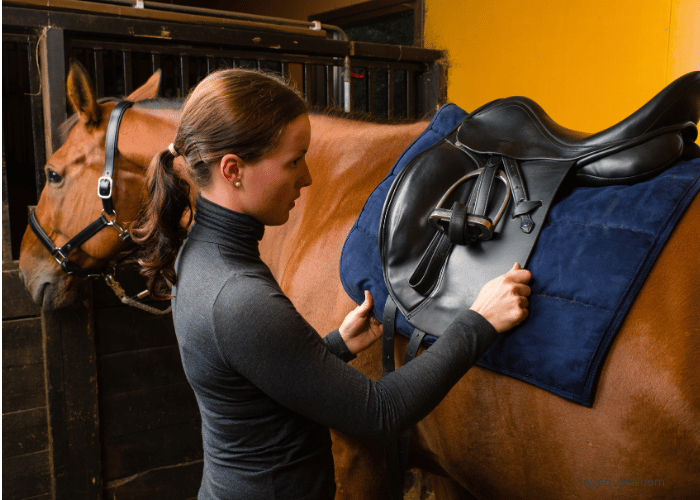
How Long Does it Take to Break a Horse?
It takes 4-6 months to get from an unbroken to a well-broken horse. But the period can be shorter or longer depending on many factors, chiefly the horse’s characteristics and the handler’s skill and experience.
Generally, it’s easier to break naturally calm horses such as Appaloosas. They are friendly and cooperative, even before breaking. So, breaking takes only a few weeks. Contrarily, Arabians and Akhal Tekes are fiery breeds that take a long time to tame.
Of course, experienced handlers get the job faster. Meanwhile, novices may take ages to make meaningful progress.
FAQs
What’s the Cost of Breaking a Horse?
Professionals charge $800-$1,200 to break a horse. It depends on the type of horse, the breed, and the temperament. Your location matters, too. Alternatively, you can pay an untrained equine enthusiast $200 to $300 for the job.
Does Breaking a Horse Hurt Them?
No, modern breaking tactics don’t hurt horses. For example, natural horsemanship and positive reinforcement are simple procedures that inflict no pain. Unfortunately, older breaking strategies, like cowboy breaking, inflict great pain.
Conclusion
Horse breaking means training the horse to become rideable. It’s a quick process in calm, friendly breeds but a nightmare in fiery breeds.
Consider professional breaking if you’re not confident in your abilities. Professional breaking costs start at $800.




